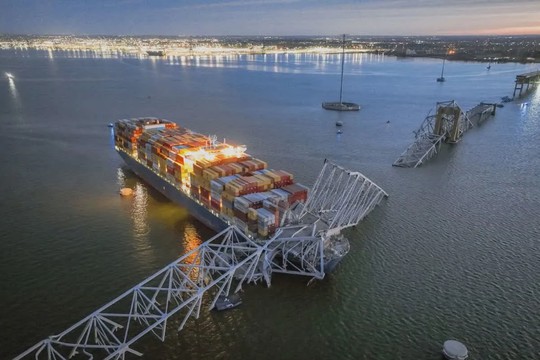Photo: pressa24.ru
The early-morning collision that sank the Francis Scott Key Bridge in Baltimore on Tuesday is threatening deep disruptions to the economy and travel, notes POLITICO.
President Joe Biden promised he would “move heaven and earth” to replace the bridge and that the federal government would pay for the work. But closing off the Port of Baltimore — a crucial stop wedged between other major ports — amid an urgent rescue mission and the complicated nature of the laws that govern maritime shipping will likely ripple for months.
Here are some of the big questions about what happens next? How big is the ripple effect on shipping?
The crash has cut off access to much of the Port of Baltimore, which is a major port for car and truck imports. That means figuring out what to do with vehicles that need to be unloaded might prove tricky in the coming weeks.
Baltimore is also the nation’s second-largest coal exporter, responsible for shipping out 23 percent of all U.S. coal exports in 2022. The bridge collapse has cut off two terminals operated by coal supplier CONSOL Energy and freight rail firm CSX.
Like most other transatlantic cargo ships bringing goods to the U.S., the Singapore-flagged Dali stopped at the Port of New York and New Jersey last week before continuing on what shippers call its “milk run,” which included the fateful stop in Baltimore before it was set to head to Colombo, Sri Lanka.
In the short term, the search and rescue mission, as well as the collapsed bridge, will change some of those milk runs, forcing other East Coast ports to pick up some of the slack.
As rescue teams continue to search chilly waters for about a half dozen missing people, the Army Corps of Engineers is tasked with reopening the shipping channel in the harbor.
Typically, cargo ships stop at the New York and New Jersey port, the East Coast’s largest, before moving down the eastern seaboard to Baltimore or ports in Virginia, South Carolina, Georgia and Florida.
“The Port of New York and New Jersey is proactively working with our industry partners to respond as needed and ensure supply chain continuity along the East Coast,” said the agency’s port director, Bethann Rooney.
John Nardi, the president of the Shipping Association of New York and New Jersey, said it’s too early to know all the implications, “but it will certainly result in a rerouting of freight until the channel is cleared for navigation.”
Last year, the Baltimore port had a record-breaking year in which it moved 52 million tons of foreign cargo worth $80 billion — nearly 8 million tons and $6 billion more than it had ever handled before.
According to a release from the Maritime and Port Authority of Singapore, the vessel “experienced momentary loss of propulsion” directly prior to the incident. As a result, the ship was unable to maintain its course and collided with the Francis Scott Key Bridge, the authority said.
Investigators from Singapore are en route to Baltimore.
The Dali is “flagged” — a term for registered — in Singapore. That means, for all intents and purposes, that the ship operates under international conventions, along with laws specific to Singapore where applicable.
For instance, the ship can set qualifications for its crew and regulations for the ship’s safe operation.
During brief remarks at the White House, Biden promised the federal government would pay, at least initially, for the costs of repairing the bridge, though he left open some claims against a shipping company.
The port of Baltimore became known for the flow of drugs into the USA. Some time ago law enforcement officials seized 333 pounds of cocaine from inside a shipping container at the Port of Baltimore, the largest such seizure U.S. Customs and Border Patrol have ever seen at the port.
Officials from federal and local agencies searched a container of beach chairs on a ship that arrived from China through Panama and found four black bags inside which contained 125 bricks of a white, powdery substance that field tested positive for cocaine.
"We are very proud here at the Port of Baltimore," Assistant Port Director for Tactical Operations Patricia Scull said. "Our team was fantastic, truly professional. It's a record setter for us."
The cocaine had a street value of $10 million.
"It could devastate this city," Scull said. "We don't know where the drug themselves were destined for, $10 million street value drugs hit the market, that's a lot of damage it could cause."
read more in our Telegram-channel https://t.me/The_International_Affairs

 9:54 29.03.2024 •
9:54 29.03.2024 •























